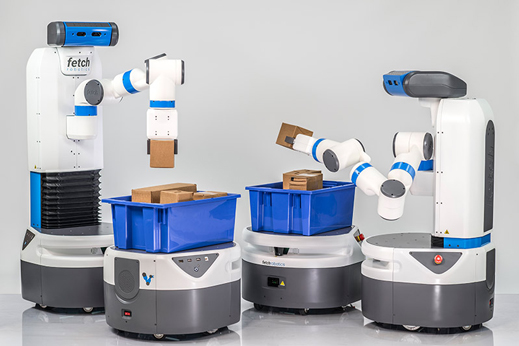A Warehouse Worker’s Best Friend—or Replacement?
As Melonee Wise walks toward a row of shelves packed with crackers, bars of soap, and other packaged goods in one corner of her workshop, a squat, wheeled robot carrying a plastic crate glides along behind, like a dog following its owner.

There’s something cute about the way the knee-high robot diligently keeps a pace or two behind Wise as she varies her pace, turns, or stops, but this is a working robot, not a toy. Wise’s startup company, Fetch Robotics, designed the robot, called Freight, as a coworker for people in warehouses. She’s demonstrating it in a fake warehouse in a corner of Fetch’s offices. But at a dozen companies working with the startup to test its idea, humans will be teaming up with Freight robots in real warehouses in the next few months.
Freight is designed to help shelf pickers, who walk around warehouses pulling items off shelves to do things like fulfilling online shopping orders. As workers walk around gathering items from shelves, they can toss items into the crate carried by the robot. When an order is complete, a tap on a smartphone commands the robot to scoot its load off to its next destination.
Wise says that robot colleagues like these could make work easier for shelf pickers, who walk as much as 15 miles a day in some large warehouses. Turnover in such jobs is high, and warehouse operators struggle to fill positions, she says. “We can reduce that burden on people and have them focus on the things that humans are good at, like taking things off shelves,” says Wise.
However, Wise’s company is also working on a second robot designed to be good at that, too. It has a long, jointed arm with a gripper, is mounted on top of a wheeled base, and has a moving “head” with a depth camera similar to that found in the Kinect games controller. This robot, named Fetch, is intended to rove around a particular area of shelving, taking items down and dropping them into a crate carried by a Freight robot.
Robots are already used in some warehouses, but usually in a limited way and not very closely alongside humans. Fetch’s Freight robot looks similar to robots made by Kiva Systems, a warehouse robotics company acquired by Amazon in 2012 (see “In Warehouses, Kiva’s Robots Do the Heavy Lifting”). But Kiva robots move whole shelves around, meaning a warehouse has to be redesigned to accommodate them. They navigate by looking for barcode stickers pasted to the floor.
Fetch’s robots navigate using a laser scanner, and are designed to integrate into the operations of existing warehouses with minimal disruption, says Wise. To create a map of any given warehouse, a company needs to steer a Freight robot around a few times using a games controller. After some annotation of the map, the robots can find their way on their own, using the 3-D data from their laser scanner to locate themselves and look out for obstacles.
Exact pricing is unavailable, in part because Fetch Robotics has only just begun to make robots. But Wise says they should cost only tens of thousands of dollars each—much less than what it would cost to employ humans, she says. She notes that the robots “don’t take potty breaks or go to lunch or take smoke breaks or get tired.” A warehouse staffed mostly by Fetch’s robots might also be able to cut the use of air-conditioning in summer and heat in winter because robots are less particular about working temperatures. And using robots could also reduce what warehouse operators euphemistically call shrinkage. “Robots don’t steal,” says Wise.
Keep Reading
Most Popular
Large language models can do jaw-dropping things. But nobody knows exactly why.
And that's a problem. Figuring it out is one of the biggest scientific puzzles of our time and a crucial step towards controlling more powerful future models.
How scientists traced a mysterious covid case back to six toilets
When wastewater surveillance turns into a hunt for a single infected individual, the ethics get tricky.
The problem with plug-in hybrids? Their drivers.
Plug-in hybrids are often sold as a transition to EVs, but new data from Europe shows we’re still underestimating the emissions they produce.
Stay connected
Get the latest updates from
MIT Technology Review
Discover special offers, top stories, upcoming events, and more.